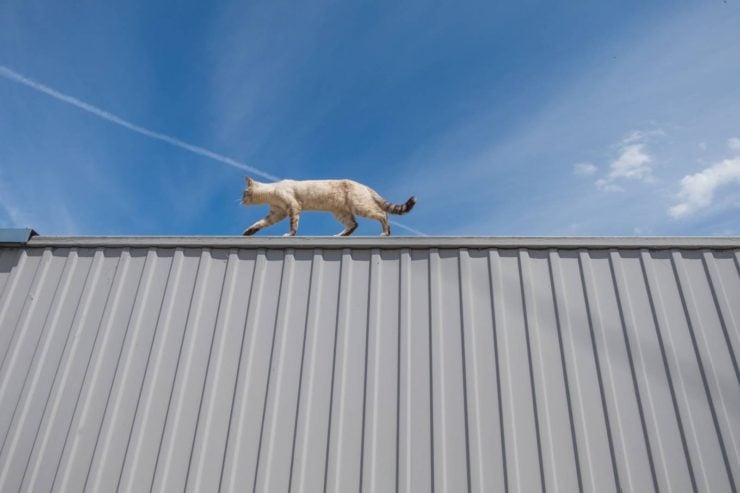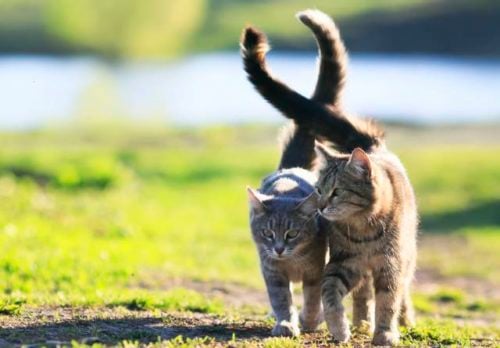Why do cats have tails is rather an ambiguous question. We are fully aware that the intent is to understand how cats use the tail for their advantage, but we will try to answer both parts of the question: Why cats have tails and how do they use them.

Foremost, asking why cats have tails, in our opinion, is a question why most animals have them. If you look around the animal kingdom, you might be surprised how very few animals are tailless. There are sponges, starfishes and others that are symmetrical across more than one axis, and they naturally do not have a tail.
Why does any animal have a tail in the first place?
Other than that, starting from annelids, continuing through reptiles and going towards mammals, tailless animals are rare. Even frogs have tails when they are tadpoles. More so, human embryos have tails at some stages of development. Sometimes, when that tail does not dissipate before birth, the story makes the news.
So, in the first place, animals have tails, because the tail is a default feature of animals with two symmetrical halves. First such animals appeared when cell clumps started to duplicate and form chains. You can see a similar pattern in today’s flatworms and earthworms, for example.
Such an arrangement makes a tail by default; it’s not possible to design a worm without a tail, for it is in essence one long tail. Since then, the tails have caught on and remained, as they turned out to be useful.

Let’s not stop there, the segmentation we mentioned is still evident in our spine and the one of your cat’s. Did you know that cats have 22 to 23 vertebrae in their tail? It indeed is an elongation of the spine.
Each vertebra has muscles attached to it, which allows the cat to move different parts of the tail independently.
But what good the tail is for cats?
Most animals have come up with different uses for their tails. Some use it for copulation, some grab tree branches with it or even carry objects around. Water animals use tail to steer, but many use their tail for other purposes, as well.
Cats mostly use their tail for balance and communication. Thankfully, they don’t use their tail to knock things off tables.
Balance
Like many animals, cats have found a use for their tails to balance. And it is such a straightforward application. When you lose balance, you’d typically spread out your arms to orient your center of mass above your feet. If you succeed, you stay upright, but, if you don’t, you might wish for a tail. Tail, in this context, serves as a third arm (or a single arm for cats) to counter any loss of balance.
But how important is this? Would a cat that has lost his tail fall over? Also, are Manx cats, a tailless cat breed, easy to lose balance? Some Manx fanciers websites will tell that they can compensate for the loss of the tail. That may be partially true, but only to a degree.
A study that looked at functions of the tail concluded that cats, after surgery to immobilize their tails, were less apt to hold their balance while walking on a moving beam. Besides, they also confirmed that cats use their tail for balance when walking on a ledge, but not so much when taking steep corners.
Of course, losing a tail does not mean the cat becomes completely helpless. Humans without one or both arms face difficulties, not small ones, but can learn to cope. If your cat has lost his tail due to an injury, he will still lead a wholesome life. He may be less agile, but that, especially for indoor cats, should not play a significant role. Also, who cares if you still love them.
Regarding Manx cats, however, there are additional problems. The reason why Manx cats have no tail is a genetic mutation which results in abnormal development of the spinal cord. As you know, most nerve signals run through the spine, and any imperfection can cause problems.
Manx Syndrome, for example, is a neurological disease which manifests itself through incontinence, improper stance, partial paralysis, pain, premature death, and other signs. You can learn more about Manx Syndrome here. Other than that, a cat without a tail would lead a normal, albeit slightly less agile, life.
Communication
Cats also use their tail as an instrument for body language. You have heard that cats communicate not only thorough voice but also through subtle body language, such as ear and whisker position, posture and the movements of the tail.
Cats can twitch and bend different parts of their tails independently. This allows for a wide range of tail positions. Unfortunately, most of these positions are poorly understood by us; we do not imply that cats have a secret signal language here, by the way.
You can quickly gauge your cat’s mood by observing its tail. For example, a lashing tail signals dislike or irritation. You should definitely stop rubbing your cat’s belly if you notice his tail is twitching.
We also know that a cat’s tail can signal an intention. An upright tail is a well-known form of greeting in cats. It also signals friendly intentions and acknowledges submission. As you come home, you might see your cat running towards you with a tail erect as a flag-post. Likely, this first evolved as a way for kittens to greet their mother and demand food from her but later expanded to become a general greeting.
The tail can also imply the animal’s size. A scared cat is likely to pull his tail towards the body to signal that he is small and harmless. In other cases, the cat may puff his tail and rise it in a bent shape. Along with other body signs, it exaggerates the cat’s size to a potential opponent, thus making the cat appear more dangerous.
Cat communication is complex; they are truly social animals. Cats can show a large variety of tail postures and they all may mean something.

Social media regularly circulate images showing positions of cats’ tails, alongside a proposed meaning of them. Though you should take them with a pinch of salt, it is indeed evident that cats use their tail for communication a lot.
Other ways how cats might use their tails
There are likely more ways how cats use their tails. For example, cats wiggle their tail when they spray urine. We don’t know if it helps the scent to spread over a larger area, but it seems plausible. Anyhow, the wiggling must have a function.
Another thing, you may have noticed that cats wave their tails during a hunt. At first, it seems counterproductive — a cat must be as invisible as possible during the cat, yet the tail movements are a potential giveaway signal. Thus, cats would not wave their tails during the hunt if there wasn’t use of it.
It may help the cat to relax back muscles by altering the load on them, or maybe it’s a way to deceive a potential prey, by creating a movement in a place that further away from where the strike comes. The latter is highly debatable, but we cannot know for sure.
Anyway, though there may be other reasons why cats have tails, we sure know that they use it for balance and communication.
